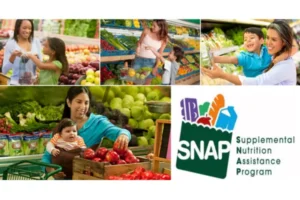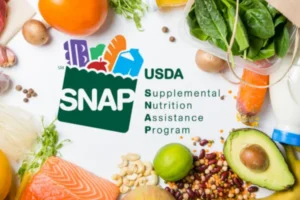Supplemental Nutrition Assistance Program
Discover how to secure your Supplemental Nutrition Assistance Program (SNAP) benefits and transform your family’s financial stability today!
Anúncios
Are you struggling to provide nutritious meals for your family each month?
Keep reading and uncover the step-by-step guide that could change your life and secure the nutritional support you deserve!
What is the Supplemental Nutrition Assistance Program (SNAP)?
SNAP, previously known as food stamps, is a federal assistance program aimed at helping low-income individuals and families afford nutritious food.
Managed by the U.S. Department of Agriculture (USDA), SNAP provides vital support by issuing monthly benefits to eligible households.
The program began in 1964 as the Food Stamp Program, evolving over decades to become SNAP.
Its main goal remains consistent: reducing hunger and promoting better nutrition among Americans who face financial hardships.
Participants in SNAP receive benefits through an Electronic Benefits Transfer (EBT) card, which functions similarly to a debit card.
This card can be used at authorized grocery stores, markets, and even some farmers’ markets.
Understanding SNAP’s purpose can ease misconceptions and highlight its significant role in supporting public health and economic stability within communities.
By providing financial assistance specifically for groceries, SNAP ensures millions of Americans can maintain a balanced and healthy diet, even during financial uncertainty or economic downturns.
Who Qualifies for the Supplemental Nutrition Assistance Program?
Eligibility for SNAP primarily depends on several key factors, including household income, resources, and certain personal characteristics such as citizenship and work status.
Income requirements are generally set at 130% of the federal poverty level for gross income and 100% for net income. This threshold varies based on household size and changes annually to reflect current economic conditions.
Asset limits also apply; typically, households must have $3,000 or less in assets if they don’t include elderly or disabled members. For households with elderly or disabled members, the limit rises to $4,250.
Work requirements apply specifically to able-bodied adults without dependents (ABAWDs). Generally, these adults must work or participate in job training for at least 20 hours per week to remain eligible.
SNAP also considers citizenship status. Eligible individuals must be U.S. citizens or qualified non-citizens residing in the state where they apply.
How the Supplemental Nutrition Assistance Program Works
SNAP benefits are calculated based on household size, income, and allowable deductions, ensuring assistance is tailored to each family’s unique financial situation.
After approval, recipients receive monthly deposits onto their EBT card. This allows them flexibility in managing their food budgets throughout the month.
The EBT card can only be used for eligible food items, such as fruits, vegetables, meats, dairy, bread, and cereals. This helps ensure nutritional needs are consistently met.
However, SNAP excludes certain items like alcohol, tobacco, vitamins, hot prepared foods, and non-food products such as household cleaning supplies or personal care products.
To help manage their benefits effectively, participants are encouraged to regularly check their balance online or via customer service numbers provided by their SNAP state agencies.
Step-by-Step Guide to Registering for the Supplemental Nutrition Assistance Program
Registering for SNAP is straightforward when you follow these clear, essential steps, helping you ensure a smooth and efficient application process:
- Step 1: Gather Necessary Documents: Collect all essential documents such as identification, Social Security numbers, proof of income, housing costs, childcare, and medical expenses to ensure a smooth application process.
- Step 2: Choose Your Application Method: Decide how you want to apply by selecting from available options: online, by mail, in person, by fax, or over the phone, based on what’s most convenient for you.
- Step 3: Complete the Application Form: Fill out the SNAP application thoroughly and accurately, providing detailed information about your household, income, expenses, and residency status.
- Step 4: Submit Required Verification Documents: Promptly submit your organized and clearly labeled verification documents through secure online portals, mail, fax, or directly at your local SNAP office.
- Step 5: Participate in an Interview: Engage in an eligibility interview to verify your application details, clarify any questions, and ensure that all provided information is accurate and complete.
- Step 6: Await Eligibility Determination: Wait for your eligibility determination, typically provided within 30 days, and prepare to supply additional documentation if needed to finalize your application.
How to Use Your SNAP Benefits Effectively
Create a monthly food budget and carefully plan meals to avoid overspending. Prioritize buying staple foods in bulk, as these items typically offer better value for your money.
Shop seasonally to save on fresh fruits and vegetables that are abundant and less costly. Incorporate more cost-effective ingredients like beans, rice, and pasta to stretch your benefits further.
Regularly track your spending to ensure you’re staying within your SNAP allowance and making the most of your monthly benefits.
Smart Shopping Strategies
Always compare prices between different brands and stores before making purchases. Take advantage of discounts, sales, and coupons available at local grocery stores.
Make a shopping list and adhere strictly to it, avoiding impulse purchases that can quickly drain your SNAP balance.
Visit farmers markets regularly, where fresh produce is often available at lower prices, especially towards the end of the day.
Consider generic brands, which often provide similar quality at lower prices, helping you maximize your SNAP benefits.
How to Find SNAP-Authorized Retailers and Farmers Markets
Utilize the USDA SNAP retailer locator available online to easily identify authorized stores.
Check community bulletin boards and local websites for nearby farmers markets accepting SNAP benefits. Contact local grocery stores directly to confirm their acceptance of SNAP.
Look out for signs indicating SNAP acceptance at markets or stores you regularly visit.
Regularly update your list of approved retailers to benefit from the best shopping opportunities close to home.
Understanding and Checking Your SNAP Balance
Regularly check your SNAP balance via online portals or dedicated mobile apps to manage your monthly food budget efficiently.
Keep all receipts and regularly compare them against your online statements to ensure accuracy.
Set a weekly or bi-weekly review schedule to monitor your balance and adjust spending habits accordingly.
Immediately report any discrepancies or unauthorized charges to customer service for prompt resolution.
Staying informed about your balance helps avoid unexpected shortages at the end of the month.
SNAP and Special Populations
SNAP Assistance for Families with Children
Families with children may receive additional SNAP benefits depending on household size, providing extra support to meet growing nutritional needs.
SNAP coordinates with school meal programs, ensuring children have access to consistent and nutritious meals year-round.
Special programs like WIC (Women, Infants, and Children) often complement SNAP benefits, particularly for families with young children.
SNAP’s nutritional education programs offer valuable resources to help families maintain a balanced diet.
Understanding these supplementary resources helps families optimize their overall food assistance support.
SNAP Benefits for Elderly Individuals
Elderly individuals often qualify for additional SNAP deductions related to medical and housing expenses, significantly enhancing their benefit amounts.
Simplified application processes make SNAP more accessible for seniors.
Extended certification periods reduce the frequency of reapplication, easing the administrative burden on elderly participants.
SNAP outreach initiatives specifically target elderly populations to increase awareness and enrollment rates.
Utilizing these tailored resources helps elderly recipients maintain health and independence through proper nutrition.
SNAP Support for Disabled Persons
SNAP provides specialized assistance for individuals with disabilities, ensuring equitable access to nutritional support.
Deductible medical expenses specific to disabled recipients often increase benefit levels.
Accessible application processes and communication methods ensure disabled individuals can independently manage their SNAP benefits.
SNAP collaborates with disability service providers to enhance outreach and support.
Awareness and utilization of these targeted resources help disabled persons fully benefit from SNAP.
SNAP and College Students: Eligibility Criteria
College students may qualify for SNAP under certain conditions, such as part-time employment, caring for dependents, or participating in federal work-study programs.
Awareness of these criteria helps eligible students significantly improve their food security during their studies.
Universities and colleges frequently partner with SNAP to provide informational sessions and application assistance.
Specialized resources such as campus food pantries often complement SNAP support.
Understanding and navigating SNAP eligibility requirements can greatly alleviate financial stress for qualifying college students.
Common Questions and Answers About the Supplemental Nutrition Assistance Program
Can I Use SNAP Benefits Across States?
SNAP benefits are usable nationwide, offering convenience during travel or relocation. You must, however, report permanent relocations to your state SNAP agency promptly.
Differences in state-specific regulations might affect certain aspects of your benefits. Staying informed helps ensure uninterrupted benefit use when crossing state lines temporarily.
Confirming benefit portability with your local SNAP office prior to traveling ensures smooth transactions.
What Happens if My Income Changes?
Income changes must be reported immediately to ensure your SNAP benefits accurately reflect your financial circumstances.
Temporary income fluctuations might result in benefit adjustments either upwards or downwards.
Providing timely updates prevents potential overpayments or underpayments.
Regular communication with your SNAP office ensures benefit accuracy.
Knowing how income changes affect your benefits allows you to plan your finances effectively.
How Often Do I Need to Reapply for SNAP?
Recertification typically occurs every 6 to 12 months, depending on your state’s guidelines and individual circumstances.
Staying aware of your recertification timeline prevents benefit interruptions.
Early preparation for recertification ensures all necessary documents and information are readily available.
Promptly responding to recertification notices maintains consistent SNAP support. Understanding this timeline helps you better manage your ongoing SNAP eligibility.
What Should I Do If I Lose My EBT Card?
Immediately report lost or stolen EBT cards to prevent unauthorized usage. Replacement cards are typically issued promptly after reporting.
Monitoring your balance after reporting ensures no unauthorized transactions occurred. Keeping customer service numbers handy allows for swift reporting.
Acting quickly minimizes potential disruptions in accessing your SNAP benefits.
Can SNAP Benefits be Transferred?
SNAP benefits are strictly non-transferable, allocated specifically to the approved household.
Misuse or unauthorized transfer of SNAP benefits can result in penalties.
Understanding this policy helps maintain your eligibility and compliance.
Educating your household members on proper use prevents accidental misuse.
Clarity on this rule ensures your benefits remain secure and properly utilized.
How SNAP Benefits Have Changed Lives
SNAP benefits have profoundly improved the quality of life for countless families across the country.
Many recipients share stories of relief, knowing they can reliably provide nutritious food for their families each month.
Parents express gratitude for the ability to regularly serve balanced meals, significantly contributing to their children’s overall health and well-being.
Additionally, SNAP has empowered individuals by relieving financial stress, enabling families to focus their limited resources on other essential needs like housing, healthcare, and education.
This stability often creates a ripple effect, leading to improved educational outcomes for children, increased employment opportunities for adults, and stronger community bonds.
Elderly individuals who receive SNAP benefits report greater independence and improved health outcomes due to consistent access to nutritious foods.
Many seniors have described SNAP as essential in maintaining their dignity and quality of life during retirement years.
Disabled recipients also greatly benefit from SNAP, describing the assistance as critical support that allows them to manage their dietary needs effectively without financial strain.
SNAP’s comprehensive support systems and tailored assistance ensure individuals with disabilities maintain adequate nutrition, contributing significantly to their overall health.
College students utilizing SNAP benefits share that the program has significantly alleviated food insecurity, allowing them to better focus on their academic goals.
This crucial support system helps students remain enrolled and succeed in their studies, shaping their future prospects positively.
Why You Should Check Your Eligibility for the Supplemental Nutrition Assistance Program Today
Checking your eligibility for SNAP is a simple yet essential step toward enhancing your food security and overall quality of life.
Many individuals underestimate their eligibility, missing out on vital assistance that could greatly reduce their financial and nutritional stress.
Verifying your eligibility today provides clarity and reassurance, ensuring you don’t miss out on potentially life-changing support.
SNAP benefits not only help meet your immediate nutritional needs but also free up resources for other critical household expenses.
Numerous resources and dedicated support channels are available to assist you with the eligibility verification process, making it accessible and straightforward.
SNAP offices, community organizations, and online portals all provide valuable assistance and guidance to help you navigate the application smoothly.
Understanding your eligibility status empowers you to make informed decisions about your household budget and food security, ultimately contributing to better health and greater financial stability.
The potential benefits of SNAP significantly outweigh any initial time investment involved in checking eligibility.
Don’t delay—take this critical step today to ensure your family receives the nutritional support you deserve.
Checking your SNAP eligibility could be the first step towards a brighter, healthier, and more secure future.




